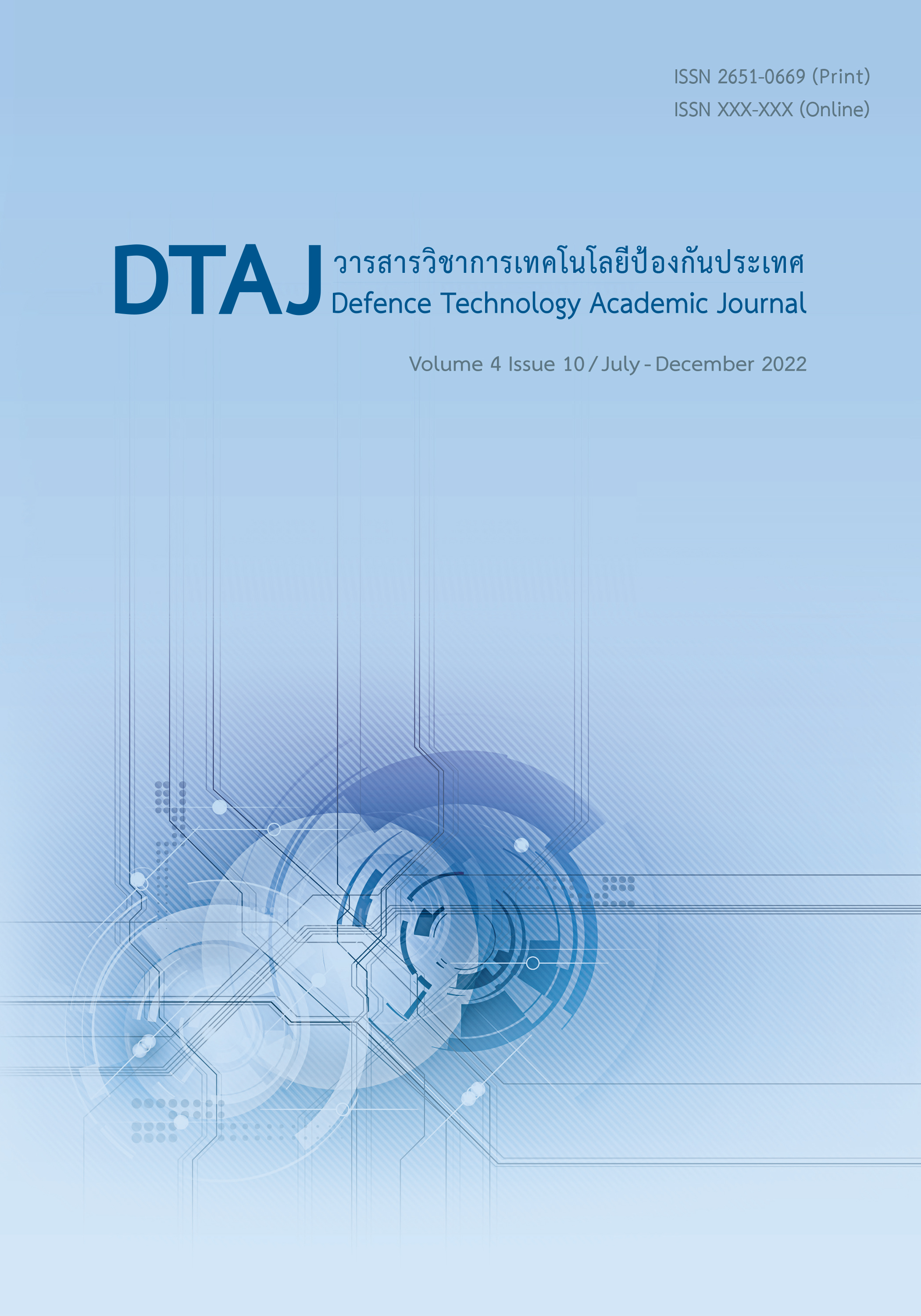The Study and Development of Artificial Intelligence (AI) Prototype for Forest Fire Detection (FFD) System using Image Data from Unmanned Aerial Vehicle (UAV)
Main Article Content
Abstract
The research project aimed 1) to monitor the specific studied area of its wildfire, using Unmanned Aerial Vehicle (UAV) 2) to study and to develop the Artificial Intelligence (AI) system in purpose of detecting wildfire in surveillance location where may occur repeated fire, using automatic steering ship. Both operations in an actual location and applied theoretical knowledge used, were tested. Those done by the results from fire forest images data of actual locations using UAV, were used to build an Artificial Intelligence prototype in detecting forest fire in the actual location. The method of the research was made with specific 655 images of fire figure included within those 3,881 images of fire figure not included. The data was divided into 3 groups; the first group was used to train, the second group was used to validation, and the last group was used to test the model. The data then was divided into 2 parts for testing, which are composed of 840 images of train model, 208 images of speed and accuracy test on model, and 208 images of performance test on model. The research was applied 4 measurement tools; Accuracy, Sensitivity, Specificity, and Matthews correlation coefficient. Those of which were specifically tested through direct validation. Aside, to do the test, the research employed 6 deep learning algorithms, which included Restnet18, Restnet34, Alexnet, Vgg11, Densenet121, and Vgg16. Separated images were also used in the research to teach models, and deep models were taught using Densenet121 on the Kaggle system. Ten ready-models for effective teaching were shown in the results. As can be observed, both the quantity of training and the accuracy percentage increased from 44.79 to 68.42, respectively.
Downloads
Article Details

This work is licensed under a Creative Commons Attribution-NonCommercial-NoDerivatives 4.0 International License.
Journal of TCI is licensed under a Creative Commons Attribution-NonCommercial-NoDerivatives 4.0 International (CC BY-NC-ND 4.0) licence, unless otherwise stated. Please read our Policies page for more information...
References
สำนักงานพัฒนาเทคโนโลยีอวกาศและภูมิ สารสนเทศ (องค์การมหาชน), “สรุปสถานการณ์ ไฟป่าและหมอกควันด้วยภาพถ่ายดาวเทียม ประจำปี 2562,” กระทรวงการอุดมศึกษา วิทยาศาสตร์ วิจัยและนวัตกรรม, 2562.
พ. เหมวรรณ. การวิเคราะห์และแปลความ ภาพถ่ายทางอากาศจากอากาศยานไร้คนขับ. เชียงใหม่: ภาควิชาภูมิศาสตร์ คณะสังคมศาสตร์ มหาวิทยาลัยเชียงใหม่, 2563.
ส. บุญธรารัตน์, ธ. เหล่าสุวรรณ, และ อ. ภุมมะกาญจนะ โรแบร์, “รูปแบบการตรวจสอบ ความเสียห าย โ ค ร ง ข่ายสายส่งไฟฟ้าด้วย อากาศยานไร้นักบิน,” วารสารวิชาการเทคโนโลยี ป้องกันประเทศ, ปีที่ 2, ฉบับที่ 4, น. 12 - 31, 2563.
พ. สันติธรรมนนท์, ภ. อุทัยศรี, และ ธ. ชื่นชม. สนามทดสอบการทำแผนที่ด้วยอากาศยานไร้คนขับ. กรุงเทพฯ: คณะวิศวกรรมศาสตร์ จุฬาลงกรณ์ มหาวิทยาลัย, 2554.
W. Sun, P. Singkhamfu, and P. Suwansrikham, “UAV Photogrammetry-Based Accident Assessment Road Condition Analysis Using Image Classification,” in Int. Conf. Digit. Arts, Media Technol., 2022, pp. 319 - 322, doi: 10.1109/ECTIDAMTNCON 53731.2022.9720398.
A. Bhradwaj, L. Sam, Akansaka, F. J. Martin -Torres, and R. Kumar, “UAVs as Remote Sensing Platform in Glaciology: Present Application and Future Prospects,” RemoteSens.Environ., vol. 175, pp. 196 - 204, 2016.
S. P. Bemis et al., “Ground-based and UAV-based Photogrammetry: A Multi-scale, High Resolution Mapping Tool for Structural Geology and Paleoseismology,” J.Struct. Geol., vol. 69, Part A, pp. 163 - 178, 2014.
C. C. Li, G. S. Zhang, T. J. Lei, and A. D. Gong, “Quick Image-processing Method of UAV without Control Points Data in Earthquake Disaster Area,” Trans.Nonferrous Met. Soc. China, vol. 21, Supplement 3, pp. s523 - s528, 2011.
J. R. R. Uijlings, K. E. A. Van de Sande, T. Gevers, and A. W. M. Smeulders, “Selective Search for Object Recognition,” Int. J. Comput.Vis., vol. 104, pp. 154 - 171, 2013.
O. Küng et al., “The Accuracy of Automatic Photogrammetric Techniques on Ultra-light UAV Imagery,” Int. Arch. Photogramm.RemoteSens.Spatial Inf. Sci., vol. XXXVIII-1/C22, pp. 125 - 130,2011.
S. Nebiker, A. Annen, M. Scherrer, and D. Oesch, “A Light-weight Multispectral Sensor for Micro UAV Opportunities for Very High Resolution Airborne Remote Sensing,” in Int. Arch. Photogramm. Remote Sens. Spat. Inf. Sci., Beijing, China, 2008, pp. 1193 - 1199.
C. A. Rokhmana, “The Potential of UAV-based Remote Sensing for Supporting Precision Agriculture in Indonesia,” Procedia Environ.Sci., vol. 24, pp. 245 - 253, 2015.
S. Ren, K. He, R. Girshick, and J. Sun, “Faster R-CNN: Towards Real-Time Object Detection with Region Proposal Networks,” in IEEE Trans. Pattern Anal. Mach. Intell., vol. 39, no. 6, pp. 1137 - 1149, 2017.
S. Siebert and J. Teizer, “Mobile 3D Mapping for Surveying Earthwork Projects Using an Unmanned Aerial Vehicle (UAV) System.” Autom. Constr., vol. 41, pp. 1 - 14, 2014.
S. Sudhakar, V. Vijayakumar, C. Sathiya Kumar, V. Priya, L. Ravi, and V. Subramaniyaswamy, “Unmanned Aerial Vehicle (UAV) based Forest Fire Detection and Monitoring for Reducing False Alarms in Forest-fires,” Comput. Commun., vol. 149, pp. 1 - 16, 2020.
M. Uysal, A. S. Toprak, and N. Polat, “DEM Generation with UAV Photogrammetry and Accuracy Analysis in Sahitler Hill,”. Measurement, vol. 73, pp. 539 - 543, 2015.
D. Ventura, M. Bruno, G. J. Lasinio, A. Belluscio, and G. Ardizzone, “A Low-cost Drone Based Application for Identifying and Mapping of Coastal Fish Nursery Grounds,” Estuar. Coast. Shelf Sci., vol. 171, pp. 85 - 98, 2016.
S. A. Vollgger and A. R. Cruden, “Mapping Folds and Fractures in Basement and Cover Rocks using UAV Photogrammetry, Cape Liptrap and Cape Paterson, Victory, Australia,” J. Struct. Geol., vol. 85, pp. 168 - 187, 2016.


